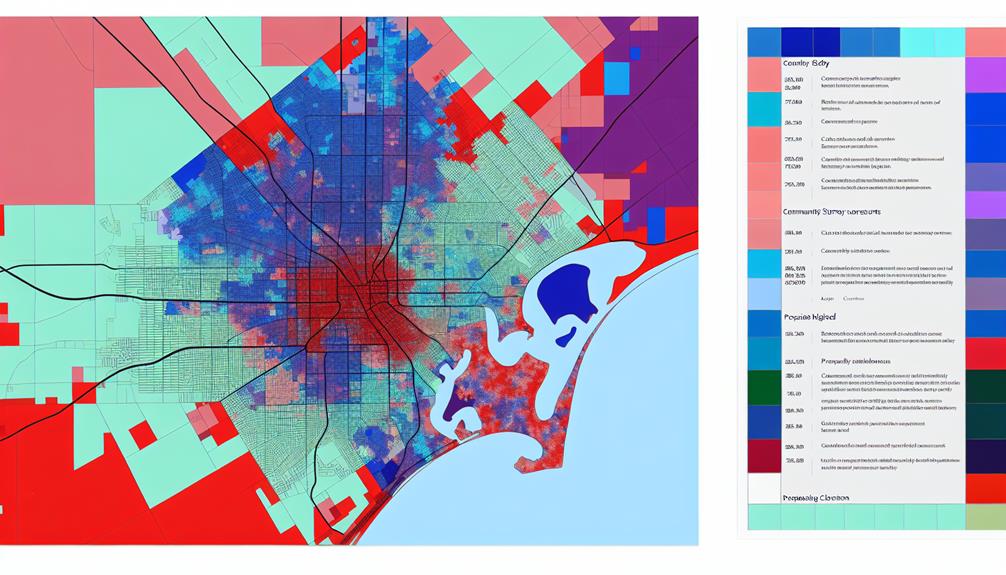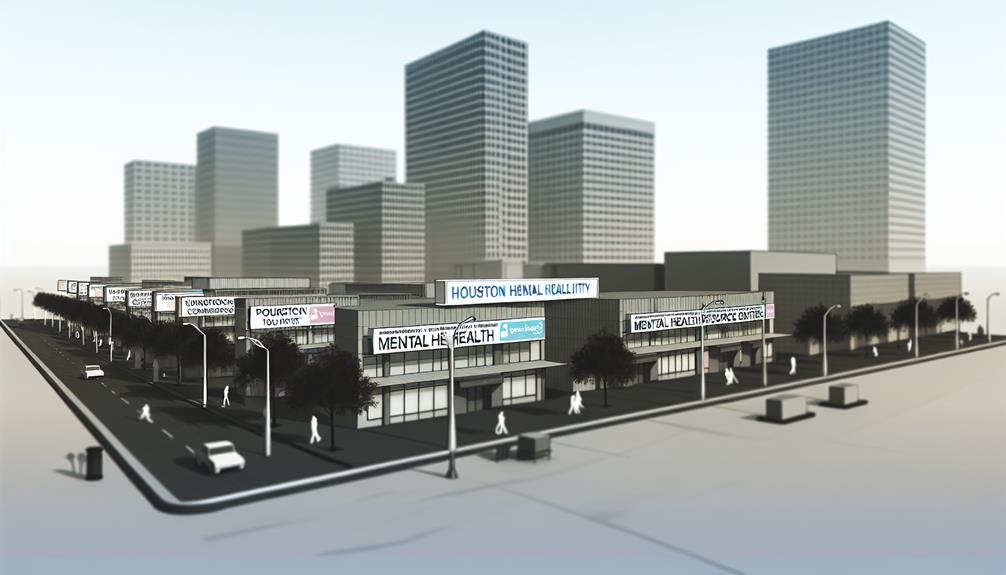Have you ever walked around the lively streets of Houston and thought about how safety initiatives could change the cityscape?
Picture a Houston where modern crime prevention methods blend with urban development, creating a safe environment for everyone.
By combining advanced technology with community-driven solutions, we can pave the way for a safer and more vibrant Houston.
Let's delve into how collaborative efforts and forward-thinking approaches can shape a brighter, secure future for all residents.
Crime Prevention Through Environmental Design
Crime Prevention Through Environmental Design (CPTED) plays a vital role in boosting safety and security in high-crime areas in Houston's development. This approach goes beyond traditional security methods to create spaces that encourage community engagement and control through urban and architectural design principles.
In Houston's high-crime neighborhoods, CPTED assessments take a comprehensive view, addressing issues like neglected lots, housing irregularities, and environmental challenges. The goal is to improve safety, security, and overall residents' quality of life.
The impact of CPTED initiatives on the community is substantial, leading to lower crime rates and increased community participation in addressing problems. Empowering residents to feel a sense of ownership and responsibility for their surroundings motivates them to actively maintain safe and secure neighborhoods.
Urban Planning and Development Preferences
Urban planning in Houston prioritizes safety and security by following the principles of Crime Prevention Through Environmental Design (CPTED). This approach focuses on involving the community and using data-driven methods to create a safer city.
Engaging with residents is key to shaping safety initiatives, making people feel responsible for their neighborhoods. Houston's urban strategies tackle crime by looking at its root causes through problem-oriented policing. By using data to make decisions, the city can target interventions where they're most needed to keep the public safe.
Collaboration between officials, law enforcement, and urban planners is crucial for implementing effective crime prevention strategies. Overall, Houston's urban planning aligns with CPTED principles to ensure a safer environment for all.
Houston Surveys

Recent surveys in Houston shed light on the concerning rise in crime rates, sparking a wave of proactive safety measures within the community.
With an uptick in anxiety among residents following a string of neighborhood shootings, there's a growing demand for effective crime prevention strategies.
Crime Rate Trends
Recent data on crime trends in Houston paint an interesting picture of the city's safety landscape. While Harris County saw a concerning 59% rise in homicides from 2019 to 2021, with a significant portion occurring in Houston, the city itself showed a slight improvement with a 3% decrease in homicides and a 10% drop in violent crimes compared to the previous year.
Property-related offenses like burglary, robbery, and larceny have been on a downward trend over the past couple of years in Houston, indicating some positive developments in this area. Mayor Sylvester Turner's decision to invest $53 million in crime reduction strategies through the One Safe Houston program underscores the city's dedication to enhancing public safety.
Although there have been improvements as noted by Houston Police Chief Troy Finner, emphasizing the need for ongoing progress in ensuring the community's safety, it's clear that there's still work to be done. The collaborative efforts and initiatives in place demonstrate a commitment to addressing the challenges and making Houston a safer place for all residents.
Community Safety Initiatives
The Harris County community is really coming together to support safety initiatives. People here are all about keeping crime down and making sure everyone feels safe. Almost everyone, like 93%, is totally on board with doing background checks for all gun sales. And get this, over 95% think it's super important to teach folks how to store guns safely. That's a big deal when it comes to preventing crime.
Another cool thing is that 91% of folks are all for putting money into programs that stop violence in our communities. It shows that we want to tackle the root of the problem. Oh, and there's this awesome push to create more jobs in high-crime areas. It just goes to show how connected jobs and crime rates really are. These stats make it clear that we're all in this together to make Houston a safer place for everyone.
Community Engagement Strategies
If you want to get the community involved in preventing crime effectively, think about starting up Neighborhood Watch programs and getting folks to join in social gatherings. These approaches not only build a sense of togetherness and accountability among residents but also provide opportunities for neighbors to team up and boost safety measures.
Active Neighborhood Watch
Getting involved in active Neighborhood Watch programs in Houston is a smart move to improve safety in your community. These programs are backed by data, showing that they help reduce crime rates and make neighborhoods safer for everyone. When residents actively participate in Neighborhood Watch initiatives, they become the eyes and ears of law enforcement, helping to prevent crimes and keep their neighborhoods secure.
Here's what you can expect from active Neighborhood Watch programs:
- Residents team up with law enforcement to keep an eye out for suspicious activities and prevent crimes.
- You'll receive training on how to prevent crime and communicate effectively with the police.
- Strong community partnerships and open communication are key to the success of these programs.
- Neighborhood Watch efforts have been proven to lower crime rates and give residents a greater sense of security.
- It's crucial to be committed to improving urban safety for these programs to work effectively.
Social Events Participation
Getting involved in community social events really helps bring people together and make neighborhoods in Houston safer for everyone. When you participate in these events, you not only get to bond with your neighbors but also build a strong support system within the community. These gatherings provide a great opportunity to talk about neighborhood safety and ways to prevent crime, which increases awareness and teamwork among residents. Check out the benefits of community events in boosting neighborhood safety and preventing crime in the table below:
| Benefits of Community Events | Impact on Neighborhood Safety |
|---|---|
| Building positive relationships | Fosters trust and unity |
| Open discussions on concerns | Heightens safety awareness |
| Strengthening neighborhood unity | Encourages joint solutions |
| Creating a safer environment | Decreases crime rates |
Law Enforcement Partnerships

In Houston, working together with law enforcement agencies like HPD and the Harris County Sheriff's Office is key to keeping our communities safe. These partnerships boost communication, coordination, and joint efforts to tackle crime effectively. By teaming up with local organizations, we build trust, promote cooperation, and find solutions to keep Houston residents secure.
One standout initiative is the Community Problem Oriented Policing (CPOP) unit, which focuses on preventing crime, engaging with the community, and testing out new strategies to address safety issues in urban areas. The Harris County Sheriff's Office, with its 5,100 employees, plays a crucial role in safeguarding the 4.1 million residents in the county.
Through Problem-Oriented Policing strategies, law enforcement agencies can take proactive steps to combat crime, interact with the community, and come up with innovative ways to enhance public safety. By prioritizing prevention and community involvement, we can create a safer environment for everyone in Houston.
Targeted Intervention Programs
Let's talk about how programs like the Crisis Intervention Response Team are changing the game when it comes to mental health crisis calls.
By teaming up mental health pros with the police force, they're making sure that folks in distress get the right kind of help they need, when they need it most.
Investing in initiatives like the Mobile Crisis Outreach Team not only boosts mental health resources but also takes some pressure off law enforcement, paving the way for a smarter and more effective crime prevention approach.
It's all about getting the right help to the right people at the right time.
Community Outreach Initiatives
In Houston, reaching out to communities at risk and building trust between residents and law enforcement is a top priority in preventing crime. This involves focusing on specific high-crime areas through targeted programs that use data to pinpoint where intervention is most needed.
Collaboration with local groups, police, and residents is key to tailoring effective solutions for each neighborhood. The ultimate aim is to empower communities to actively engage in crime prevention, leading to safer streets and a drop in criminal activities.
Data-Driven Strategies
In the quest to tackle crime and boost community safety in Houston, using data-driven tactics and targeted intervention programs is key. These methods help pinpoint high-crime areas and individuals most at risk of violent behavior. By analyzing data, law enforcement can spot trends in violent crime, enabling tailored interventions that address root causes and prevent future incidents.
These focused programs aim to lower recidivism rates by providing specialized support and resources to those most prone to reoffending. Through data-driven strategies, law enforcement can allocate resources effectively, leading to more impactful crime prevention efforts and enhanced community safety.
Mental Health Resource Accessibility

Improving access to mental health resources plays a crucial role in addressing the underlying causes of certain crimes and reducing police involvement in nonviolent mental health situations in Houston's development. The city's recent efforts signify a strategic shift towards prioritizing mental health and crisis intervention to bolster urban safety.
Here are some key highlights to consider:
- Houston has earmarked $12 million for a Mobile Crisis Outreach Team program aimed at redirecting nonviolent mental health calls away from HPD.
- The city has expanded the Crisis Intervention Response Team program by securing additional funding to better link HPD with mental health professionals during crisis incidents.
- Data underscores the significant correlation between mental health issues and a notable portion of police encounters, underscoring the pressing need for enhanced mental health resources.
- The emphasis on mental health initiatives is geared towards tackling the root causes of specific crimes and diminishing police involvement in nonviolent mental health scenarios.
- Through investments in mental health services and crisis intervention teams, Houston strives to enhance community safety and well-being while curbing unnecessary police interventions.
These initiatives reflect a proactive approach to promoting mental wellness and safety within the community, showcasing a commitment to addressing mental health challenges effectively.
One Safe Houston Initiative
Houston is facing a serious uptick in homicides, prompting Police Chief Troy Finner to lead the charge with the One Safe Houston Initiative. This $52 million program zeroes in on the 200 most violent offenders to beef up security measures. By tapping into funds from the federal American Rescue Plan Act, the initiative aims to tackle the surge in violent crime in Harris County head-on.
The One Safe Houston Initiative rolls out crisis intervention teams, beefs up law enforcement presence in high-crime areas, launches a gun buyback program, and invests in violence reduction initiatives. These targeted actions are driven by data and focus on tackling the root causes of violence while simultaneously beefing up security. Praised by the White House ARPA Coordinator for its effectiveness, this initiative showcases a proactive approach to boosting public safety and slashing crime rates in Houston.
Criminal Case Backlog Reduction

Dealing with Houston's overwhelming backlog of more than 100,000 criminal cases demands urgent action to streamline the Harris County court system. Clearing this backlog is crucial not just for timely justice delivery but also for effective crime prevention.
To tackle this issue effectively, we need to take some key steps:
- Allocate $3 million to swiftly resolve misdemeanor and felony cases.
- Increase the number of courts, judges, and staff to manage the high caseload effectively.
- Enforce a proposed law to regulate bail bond fees for quicker backlog handling.
- Ensure prompt sharing of evidence, vital for speeding up case resolutions.
- Secure additional funds to reduce case backlogs and bolster crime prevention measures.
It's time to take decisive action to address this pressing issue and ensure a more efficient and effective legal system for all.
Public Safety Infrastructure Enhancement
In Houston, we're making big moves to boost public safety through the One Safe Houston program. With a hefty $53 million investment, we're serious about stepping up security. Think more lights and mandatory security cameras in high-crime spots to keep a close eye on things and scare off troublemakers.
We're also tackling court backlogs and revamping the bail bond system to speed up cases and cut down on delays in the justice system. Teaming up with the Harris County Sheriff's Office and running community programs like CPOP are all part of our plan to beef up safety in the city.
And hey, we're all about using smart data too, like checking out businesses with Crime Prevention Through Environmental Design (CPTED) assessments. It's all hands on deck to make Houston safer and better for everyone.
Creating a Resilient Urban Environment

When it comes to boosting urban resilience in Houston, it's crucial to incorporate smart strategies that bolster community safety and cut down on criminal activities. One effective approach is integrating Crime Prevention through Environmental Design (CPTED) tactics into city planning to create a safer and more resilient urban landscape.
- Using CPTED strategies can beef up urban safety by minimizing opportunities for crime.
- CPTED hones in on urban and architectural design elements to deter criminal behavior and enhance community well-being.
- Encouraging territorial control and community involvement through CPTED methods can help prevent victimization and improve the overall urban living experience.
- Tailored CPTED assessments provide customized solutions for businesses and homes in Houston to address specific crime prevention needs.
- By weaving CPTED principles into urban planning, Houston can make strides in reducing crime rates and fostering a more secure and resilient city environment.
Frequently Asked Questions
What Is the Crime Prevention Program in Houston?
In Houston, they've got this awesome program called One Safe Houston that's all about keeping the community safe. They're really focused on cutting down violence, helping out in emergencies, teaming up with the neighborhood, and reaching out to young folks. They're stepping up by putting more cops in areas with lots of crime, offering a sweet deal with a gun buy-back program, and making sure parks are safe for everyone. It's all about looking out for each other and making sure Houston stays a great place to live.
How Can Urban Planning Reduce Crime?
When it comes to making neighborhoods safer and reducing crime, urban planning plays a crucial role. By following Crime Prevention Through Environmental Design (CPTED) principles, we can create communities that deter criminal activities and promote safety. One effective way to achieve this is through mixed-use developments that blend residential and commercial spaces, enhancing natural surveillance.
To boost safety, it's essential to design streets with active fronts, encouraging people to be present and watchful. Adequate lighting also plays a significant role in creating environments where criminals are less likely to thrive. Furthermore, incorporating affordable housing options and community centers fosters a sense of unity among residents, making it harder for criminal elements to take hold.
Is It Safe to Walk Alone in Houston?
Absolutely, walking alone in Houston is generally safe. While the city does face some crime challenges, there have been significant improvements in urban safety thanks to collaborative efforts. Participating in workshops and programs geared towards enhancing personal safety is a great way to stay informed and aware of your surroundings.
Is Houston a Safe Place to Live?
Living in Houston is pretty safe these days, with crime rates on a downward trend. In September, we saw a 3% decrease in homicides and a significant 10% drop in violent crimes. It's reassuring to note that ongoing efforts like One Safe Houston are actively working to make our city even safer.
